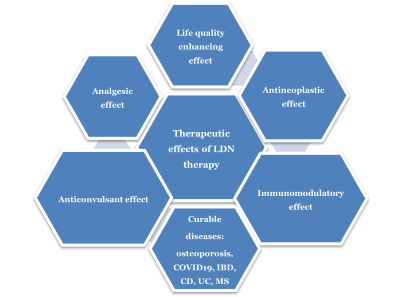Current pharmacotherapeutic properties of low-dose naltrexone therapy in humans and possible therapeutic and prophylactic indications in cats and dogs
Authors: Reza G. Marangaloo, Orhan Pinar, Tandzhu Mehmedov and Mehmet E. Or
Ger. J. Vet. Res
2024.
vol. 4, Iss. 1
pp:39-45
Doi: https://doi.org/10.51585/gjvr.2024.1.0070

Abstract:
Naltrexone was first developed in 1963 as an opioid antagonist for therapeutic use in opioid-dependent individuals (alcohol, narcotics, and tobacco) with a 50 mg/day dose approved by the Food and Drug Administration (FDA). In 1985, Dr. Bernard Bihari explained that when naltrexone is taken in very low doses (1-5 mg/day) before bedtime, it blocks opioid receptors for 2- 4 hours and leads to the release of endorphins in the early morning hours, serving as an opioid agonist and immunomodulatory agent. This extra endorphin secretion has been proven to enhance the immune system response in AIDS patients. Endogenous opioids that affect cell development are referred to as opioid growth factor (OGF) and met-enkephalin (ME). Low-dose-naltrexone (LDN) pharmacotherapeutically possesses immunomodulatory, anticarcinogenic, antiviral, antibacterial, antiparasitic, and antifungal properties. LDN also increases the production and sensitivity of OGF, ME, and OGF receptor (OGFr) in the bloodstream, thereby enhancing quality of life. Based on these pharmacotherapeutic properties, LDN application is believed to be effective in the treatment or prophylaxis of various infectious diseases in cats and dogs, particularly vasculitis-related diseases such as feline infectious peritonitis (FIP) and infectious canine hepatitis (ICH), hypothyroidism, gastrointestinal disorders, spondylosis, rheumatoid arthritis, autoimmune diseases, pneumonia, atopic and allergic dermatitis, pyodermas, resistant pyodermas, methicillin-resistant Staphylococcus aureus (MRSA) or various gastrointestinal disorders, alopecia, stubborn dermatomycosis, stubborn demodicosis, various geriatric and oncogenic diseases, and deep depressions or obsessive-compulsive disorders. Thus, this review aims to evaluate the pharmacotherapeutic properties of LDN therapy usage and mechanisms of action in detail and assess the potential indications in cats and dogs based on these mechanisms.
Keywords:
Immunomodulators, Therapy, Low-dose-naltrexone, LDN, Cats, Dogs
Statistics:
Article Views: 2249
PDF Download: 60